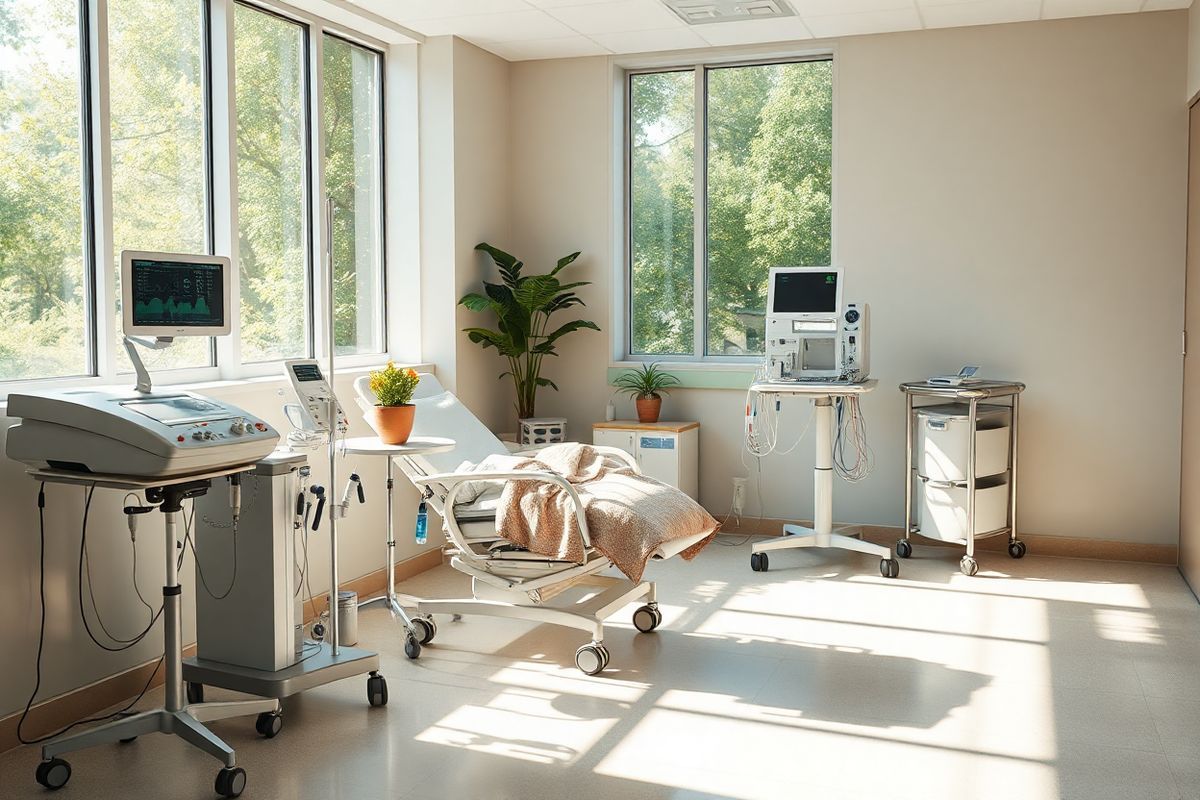Table of Contents
The Essential Role of Hemodialysis in Kidney Disease Management

Hemodialysis is a medical procedure that cleanses the blood of waste products when the kidneys can no longer perform this function effectively. It involves the use of a machine known as a dialyzer, which acts as an artificial kidney. The process typically occurs in a dialysis center and may require patients to attend sessions three to five times a week, with each session lasting approximately three to five hours (Cleveland Clinic, 2024).
The need for hemodialysis arises when a patient’s kidney function deteriorates significantly, often due to chronic conditions such as diabetes and high blood pressure. These conditions can damage the kidney’s filtering structures, leading to end-stage renal disease (ESRD), where the kidneys operate at only 10-15% of their normal capacity (National Kidney Foundation, 2024). In such instances, hemodialysis is not merely a treatment; it is a lifeline that allows patients to manage their condition and maintain a semblance of normalcy in their daily lives.
Benefits of Hemodialysis
Hemodialysis provides numerous benefits for patients with kidney failure, including:
- Removal of Waste and Toxins: Hemodialysis effectively removes urea, creatinine, and excess electrolytes from the blood, preventing the toxic buildup that can lead to serious health complications (Cleveland Clinic, 2024).
- Fluid Management: The procedure helps manage fluid balance, which is crucial in preventing complications such as heart failure and pulmonary edema (CDC, 2024).
- Blood Pressure Regulation: Hemodialysis can contribute to better control of blood pressure, reducing the risk of cardiovascular events (National Kidney Foundation, 2024).
- Quality of Life: With regular treatment, many patients report improvements in energy levels and overall well-being, enabling them to engage more fully in daily activities (Cleveland Clinic, 2024).
Recognizing the Symptoms and Causes of Kidney Disease
Early detection of kidney disease is essential for effective management and can significantly impact patient outcomes. Unfortunately, many individuals with ckd do not exhibit symptoms until the disease has progressed considerably. Common symptoms of kidney disease may include:
- Fatigue: Patients often feel tired or weak due to the accumulation of waste in the bloodstream (National Kidney Foundation, 2024).
- Swelling: Fluid retention can lead to swelling in the ankles, feet, or hands, a condition known as edema (CDC, 2024).
- Changes in Urination: Increased frequency of urination, especially at night, or urinating less than usual can indicate kidney issues (National Kidney Foundation, 2024).
- Blood in Urine: Hematuria, or blood in the urine, can be a sign of kidney dysfunction or damage (CDC, 2024).
- Foamy Urine: Excessive bubbles in the urine may suggest proteinuria, indicating that the kidneys are not filtering proteins properly (National Kidney Foundation, 2024).
Common Causes of Kidney Failure
Several underlying conditions can contribute to the onset of CKD and subsequent kidney failure. The most prevalent causes include:
- Diabetes: High blood sugar levels can damage blood vessels in the kidneys over time, impairing their filtering ability (CDC, 2024).
- Hypertension: Prolonged high blood pressure can strain the kidneys, leading to damage (National Kidney Foundation, 2024).
- Glomerulonephritis: Inflammation of the kidney’s filtering units can result in kidney damage (CDC, 2024).
- Polycystic Kidney Disease: This genetic disorder causes cysts to form in the kidneys, leading to kidney dysfunction (CDC, 2024).
- Obstruction: Conditions such as kidney stones or enlarged prostate can block the flow of urine, resulting in kidney damage (CDC, 2024).
Exploring the Hemodialysis Process: How It Works

The hemodialysis process involves several key components, starting with the creation of a vascular access that allows for blood removal and return. This access can be established in different ways, including:
-
Arteriovenous (AV) Fistula: A surgeon connects an artery directly to a vein, typically in the arm. This method is preferred due to its durability and lower complication rates (Kidney.org, 2024).
-
AV Graft: If blood vessels are not suitable for a fistula, a graft, which is a piece of tubing, is used to connect an artery to a vein (Kidney.org, 2024).
-
Catheter: A catheter may be placed in a large vein for temporary access, especially in emergency situations (Cleveland Clinic, 2024).
The Dialysis Session
During a hemodialysis session, the following steps occur:
- Preparation: Patients are weighed, and their blood pressure and temperature are monitored to establish a baseline for treatment (Cleveland Clinic, 2024).
- Blood Removal: Two needles are inserted into the access site. One needle draws blood out of the body to the dialyzer, while the other returns cleaned blood (Cleveland Clinic, 2024).
- Filtration: Inside the dialyzer, blood flows through a series of membranes that filter out toxins and excess fluids. The dialysate, a special fluid, removes waste products from the blood (Cleveland Clinic, 2024).
- Monitoring: Healthcare providers continuously monitor the patient’s vital signs and the dialysis machine to ensure optimal treatment (Cleveland Clinic, 2024).
- Completion: Once the session is finished, the needles are removed, and the access site is bandaged. Patients are often advised to rest for a short period before resuming normal activities (Kidney.org, 2024).
Risks and Complications
While hemodialysis is essential for patients with kidney failure, it is not without risks. Common complications include:
- Infections: Vascular access sites can become infected, leading to serious complications (Cleveland Clinic, 2024).
- Low Blood Pressure: Patients may experience hypotension during or after treatment (Cleveland Clinic, 2024).
- Muscle Cramps: Many patients report muscle cramps during dialysis sessions, which can be uncomfortable (Cleveland Clinic, 2024).
- Fatigue: Post-treatment fatigue is common, often lasting several hours after a session (Cleveland Clinic, 2024).
- Anemia: Hemodialysis can contribute to anemia, as it may lead to decreased red blood cell production (CDC, 2024).
Types of Dialysis: Choosing the Right Option for You
There are two primary types of dialysis: hemodialysis and peritoneal dialysis. Each has its own benefits and considerations, and the choice often depends on individual patient needs and lifestyle.
Hemodialysis
As discussed, hemodialysis uses a machine to clean the blood. It is typically performed in a dialysis center, but home dialysis options are also available, allowing for greater flexibility (Cleveland Clinic, 2024). Patients may choose to undergo conventional, short daily, or nocturnal hemodialysis based on their medical needs and lifestyle preferences.
Peritoneal Dialysis
Peritoneal dialysis involves using the lining of the abdomen (the peritoneum) to filter blood inside the body. A catheter is surgically placed in the abdomen, allowing a cleansing solution to be infused and drained. This method can be performed at home and offers the advantage of more flexibility in scheduling (UMMC, 2024).
Factors to Consider When Choosing Dialysis
When deciding between hemodialysis and peritoneal dialysis, patients should consider several factors, including:
- Lifestyle: Work schedules, family commitments, and personal preferences can influence the choice of dialysis.
- Health Conditions: Other existing health issues may affect the type of dialysis that is safest and most effective.
- Training and Support: Patients and caregivers may need training for home dialysis, which can be a consideration for those who prefer independence.
- Access to Facilities: Availability of dialysis centers and resources for home dialysis can also impact the decision (Cleveland Clinic, 2024).
Living with Kidney Disease: Lifestyle Changes and Support Systems
Managing kidney disease often requires significant lifestyle changes to improve health outcomes and quality of life. Patients are encouraged to adopt a proactive approach to their health, which includes:
- Dietary Modifications: Adhering to a renal diet that limits sodium, potassium, and phosphorus intake can help control symptoms and manage kidney function (NHS, 2024).
- Regular Monitoring: Frequent check-ups and blood tests help monitor kidney function and adjust treatments as necessary (NIDDK, 2024).
- Medication Compliance: Taking prescribed medications regularly is crucial for managing blood pressure, diabetes, and other related conditions (NIDDK, 2024).
- Physical Activity: Engaging in regular exercise can improve overall health and well-being, although patients should consult healthcare providers for tailored recommendations (CDC, 2024).
- Psychosocial Support: Joining support groups or counseling can help individuals cope with the emotional aspects of living with kidney disease (NIDDK, 2024).
Support Systems
Support systems play a vital role in helping patients navigate the complexities of kidney disease. These may include:
- Healthcare Teams: Nephrologists, dietitians, and social workers can provide comprehensive care tailored to the individual needs of patients.
- Family and Caregivers: Support from family members and caregivers can enhance treatment adherence and provide emotional backing.
- Patient Advocacy Groups: Organizations such as the National Kidney Foundation offer resources, education, and community support for individuals with kidney disease (National Kidney Foundation, 2024).
Frequently Asked Questions (FAQ)
1. What is the purpose of hemodialysis?
Hemodialysis is a treatment designed to remove waste products, excess fluids, and toxins from the blood when the kidneys can no longer perform these functions. It also helps regulate electrolytes and blood pressure (Cleveland Clinic, 2024).
2. How often do I need to undergo hemodialysis?
Most patients undergo hemodialysis three times a week, with each session lasting about three to five hours. Some patients may opt for more frequent home hemodialysis sessions (Cleveland Clinic, 2024).
3. What are the risks associated with hemodialysis?
Common risks include infections at the access site, low blood pressure, muscle cramps, fatigue, and anemia. Patients are encouraged to communicate any concerns with their healthcare team (Cleveland Clinic, 2024).
4. Can I perform hemodialysis at home?
Yes, many patients are trained to perform hemodialysis at home, allowing for greater flexibility in scheduling. Home hemodialysis often involves shorter, more frequent sessions, which can be easier on the body (Cleveland Clinic, 2024).
5. What lifestyle changes should I consider with kidney disease?
Patients are advised to adopt a renal diet, monitor their blood pressure, engage in physical activity, and maintain regular medical check-ups. Support from healthcare providers, family, and community resources is also essential (NIDDK, 2024).
References
- Chronic kidney disease (CKD). (n.d.). Retrieved from https://www.kidney.org/kidney-topics/chronic-kidney-disease-ckd
- Cleveland Clinic. (2024). Hemodialysis: What It Is, Types & Procedure. Retrieved from https://my.clevelandclinic.org/health/treatments/24472-hemodialysis
- National Kidney Foundation. (2024). 10 Signs You May Have Kidney Disease. Retrieved from https://www.kidney.org/news-stories/10-signs-you-may-have-kidney-disease
- UMMC. (2024). Types of Dialysis | Hemodialysis and Peritoneal Dialysis | Kidney Disease. Retrieved from https://www.umms.org/ummc/health-services/kidney/dialysis/types
- CDC. (2024). Chronic Kidney Disease Basics. Retrieved from https://www.cdc.gov/kidney-disease/about/index.html











